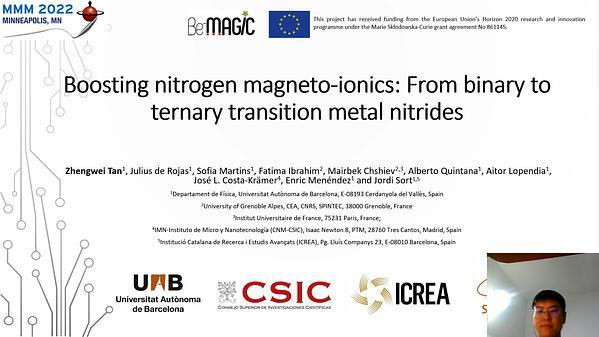Would you like to see your presentation here, made available to a global audience of researchers?
Add your own presentation or have us affordably record your next conference.
We predict how design aspects of the HAMR system such as media properties, thermal profile, and the geometry of the magneto-resistive (MR) reader affect user density through micromagnetic simulation 1. It is found that maximum user density is achievable by optimizing the track pitch. Fig 1. shows dependence on track pitch for a small grain pitch, fly height, and thermal spot size: Fig 2. shows corresponding data for large values. User density increases when the value of shield-to-shield spacing (SSS) of the reader is reduced owing to improved resolution, even though SNR often decreases 2. Moreover, the impact of the shield-to-shield spacing is much stronger in case of small grain size compared to larger grain size because the limit to resolution becomes the transition broadening induced by the grain pitch. It is also evident that higher full width at half maximum (FWHM) of the temperature profile reduces user density owing mostly to increased track pitch, but also owing to increased erase after write. Transition curvature in combination with shingled recording is predicted to yield asymmetric transitions with respect to the track center 3. Therefore, to adequately match the curvature of these asymmetrical curved transitions, we employed a rotated read head rotation: a single rotated head ( θopt = 350 ) results in a 9% improvement in user density over a single non-rotated head at 5.8 nm grain pitch, 15 nm reader width, 30 nm FWHM, 16 nm SSS, and 15 nm track pitch. Finally, we also demonstrate that media Tc variation impacts density more severely at high densities, but anisotropy field variation is the more significant effect at lower densities.
References:
1 R. H. Victora and P.-W. Huang, IEEE Trans. Magn., vol. 49, no. 2, pp. 751–757, (2013)
2 Z. Liu, Y. Jiao, and R. H. Victora, Appl. Phys. Lett., vol. 108, no. 23, p. 232402, (2016)
3 W.-H. Hsu and R. H. Victora, Appl. Phys. Lett., vol. 118, no. 7, p. 72406, (2021)

Fig. 1. User density as a function of track pitch for different shield-to-shield spacing (SSS) of ECC (FePt) media for optimal bit length = 9nm and reader width =15nm.

Fig. 2. User density profile as a function of track pitch for different shield-to-shield spacing (SSS) of ECC (FePt) media for optimal bit length = 9nm and reader width =15nm.
